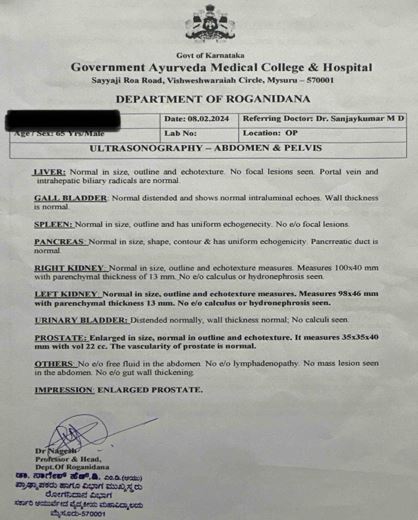Avapeedaka Snehapana: A Novel Therapeutic Protocol in the management of Mutrashmari (Urolithiasis) - A Case Report
DOI:
https://doi.org/10.21760/jaims.9.7.52Keywords:
Avapeedaka Snehapana, Mutrashmari, Renal Calculi, Urolithiasis, Vastyamayantaka GruthaAbstract
Mutrashmari (~renal stone) is characterized by formation of Ashma (~stone-like substance) in Mutravaha Srotas (~urinary system). Due to similarities in clinical manifestations Mutrashmari can be correlated to Urolithiasis. Urolithiasis is characterized by the formation of solid masses or calculi within the urinary system. Increasingly prevalent worldwide, its prevalence in India mirrors global trends, at around 12%. Men are affected more than women with male to female ratio of 3:1. Chronic and recurrent nature underscores its significant impact on healthcare emphasizing the need for effective management strategies. Avapeedaka Snehapana is one such novel therapeutic protocol, where Sneha (~medicated ghee) is administered before and after digestion of meal, commonly indicated in Adhonabhigata Vikaras (~diseases manifesting below umbilicus) specific to Mutravaha Sroto Dushti (~Urinary system disorders). In this case report, a male patient of age 65 years diagnosed with Urolithiasis since 1 year visited Out Patient Department (OPD) with symptoms of pain in left flank region, associated with burning micturition. Ultrasonography report revealed a 7 mm calculus located at upper pole of left kidney. Patient was administered Avapeedaka Snehapana with Vastyamayantaka Grutha. Patient exhibited remarkably positive outcomes, with symptoms completely resolved and Ultrasonography report confirming absence of calculi post-treatment.
Downloads
References
Vaidya HariSastri Paradakara, editor. Commentary Sarvangasundara of Arunadatta, on Astangahrdaya of Vagbhata, Sutra sthana; Roganutpadaniya adhyaya: chapter 4, verse 6-7. 10th ed. Varanasi: Chaukhamba Surabharati Prakashan; 2019. p.54.reprint 2019
Acharya YT, editor. Charaka samhita of Agnivesha, Chikitsa sthana; Vatavyadhi chikitsa: chapter 28, verse 99.Varanasi: Chaukhamba Orientalia; 2021. p. 621. reprint 2021.
Acharya YT, editor. Susruta samhita of Susruta, Chikitsa sthana; Ashmari chikitsa: chapter 7, verse 3. Varanasi: Chaukhamba Orientalia; 2021. p. 435. reprint 2021.
Acharya YT, editor. Susruta samhita of Susruta, Nidana sthana; Ashmari nidana: chapter 3, verse 7. Varanasi: Chaukhamba Orientalia; 2021. p. 277. reprint 2021.
Sofia NH, Manickavasakam K, Walter TM. Prevalence and risk factors of kidney stone. GJRA. 2016;5:183–187.
Carella A, Leo S, Infante B, Hoznek A, Grandaliano G, Stallone G. Nephrolithiasis in the elderly. Nephrol Dial Transplant. 2023; 28(2):123-127.
Shenoy KR, Shenoy Anitha, editors. Manipal Manual of Surgery. Kidney and Ureter. Chapter 39. 4th ed. India: CBS Publishers; 2014. p.938-939
Acharya YT, editor. Susruta samhita of Susruta, Chikitsa sthana; Ashmari chikitsa: chapter 7, verse 4. Varanasi: Chaukhamba Orientalia; 2021. p. 435. reprint 2021.
Acharya YT, editor. Commentary Ayurveda dipika of Chakrapanidatta on Charaka samhita of Agnivesha, Sutra sthana; Navegandharaniya adhyaya: chapter 7, verse 5-25. Varanasi:Chaukhamba Orientalia; 2021. p.51. reprint 2021.
Vidyanath R, Nishteswar K, editors. Sahasrayogam, Grutha prakarana: 21. 2nd ed. Varanasi: Chowkhamba Sanskrit Series Office; 2008. p.75.
Mooss Vayaskara NS, editor. Commentary Vakyapradeepika of Parameswara on Ashtanga Hridaya of Vagbhata, Part 1; Sutra sthana: chapter 4, verse 6-7. 1st ed. Kottayam: Vaidyasarathy Press; 1950. p. 60.
Bhattacharya JV (ed). Chikitsa Sara Sangraha, Sri Vangsena Samhita; Snehapana Adhikara: chapter 12. 2nd edition. Calcutta: University Press;1892. p. 96.
Parameshwari LH, Kulkarni V. A comparative clinical study to evaluate the efficacy of Avapeedaka Sneha Pana in fixed and increasing dose with Trinapanchamoola Ghrita in Mootrashmari (Urolithiasis). J Emerging Technologies Innovative Res. 2024 Jan;11(1):774.
Vaidya HariSastri Paradakara, editor. Commentary Sarvangasundara of Arunadatta, on Astangahrdaya of Vagbhata, Sutra sthana; Roganutpadaniya adhyaya: chapter 4, verse 6-7. 10th ed. Varanasi: Chaukhamba Surabharati Prakashan; 2019. p.54.reprint 2019
Kumar A, Lalotra A. Ayurvedic approach for the treatment of Ashmari. J Ayurveda Integr Med. 2023 Apr 15;14(2):156-162.
Manju P, Shubada VI. A Comparative Clinical Study To Evaluate The Efficacy of Vastyamayantaka Ghrita And Chincha Kshara In Mutraashmari W.S.R To Urolithiasis. Int J Ayurvedic Herb Med. 2017;7(5):2903-29075. doi:10.18535/ijahm/v7i5.09.















